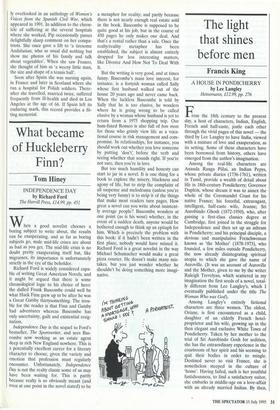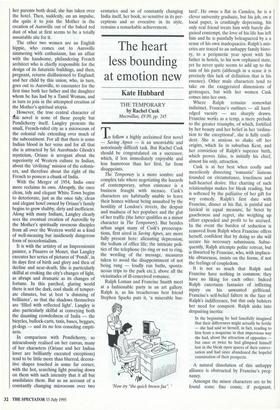The light that shines before men
Francis King
A HOUSE IN PONDICHERRY by Lee Langley Heinemann, £12.99, pp. 276 From the 18th century to the present day, a host of characters, Indian, English, French and half-caste, jostle each other through the vivid pages of this novel — the third by Lee Langley to have India, viewed with a mixture of love and exasperation, as its setting. Some of these characters have been borrowed from history, others have emerged from the author's imagination.
Among the real-life characters are Ananda Ranga Pillai, an Indian Pepys, whose private diaries (1736-1761), written in Tamil, provide a wealth of detail about life in 18th-century Pondicherry; Governor Dupleix, whose dream it was to annex the whole of the Coromandel Coast for his 'native France; his forceful, extravagant, intelligent, half-caste wife, Jeanne; Sri Aurobindo Ghosh (1872-1950), who, after gaining a first-class classics degree at Cambridge, first joined in the struggle for Independence and then set up an ashram in Pondicherry; and his principal disciple, a devious and manipulative Frenchwoman known as 'the Mother' (1878-1973), who founded, a few miles outside Pondicherry, the now already disintegrating spiritual utopia to which she gave the name of Auroville. (It was an account of Auroville and the Mother, given to me by the writer Raleigh Trevelyan, which scattered in my imagination the first seeds of a novel, total- ly different from Lee Langley's, which I eventually published under the title The Woman Who was God).
Among Langley's entirely fictional characters are three women. The oldest, Oriane, is first encountered as a child, daughter of an elderly French hotel- proprietor and his wife, growing up in the then elegant and exclusive White Town of Pondicherry. Taken by her mother to the trial of Sri Aurobindo Gosh for sedition, she has the extraordinary experience in the courtroom of her spirit and his seeming to quit their bodies in order to mingle. Destined never to visit France, she is nonetheless steeped in the culture of 'home'. Having failed, such is her youthful fastidiousness, to find a satisfactory suitor, she embarks in middle-age on a love-affair with an already married Indian. By then, her parents both dead, she has taken over the hotel. Then, suddenly, on an impulse, she quits it to join the Mother in the creation of Auroville out of the baked red dust of what at first seems to be a totally unsuitable site for it.
The other two women are an English hippie, who comes out to Auroville simmering with enthusiasm, has an affair with the handsome, philandering French architect who is chiefly responsible for the design of its futuristic buildings, and then, pregnant, returns disillusioned to England; and her child by this union, who, in turn, goes out to Auroville, to encounter for the first time both her father and the daughter whom he has had by a Tamil Woman, and in turn to join in the attempted creation of the Mother's spiritual utopia.
However, the true central character of tts novel is none of these people but Pondicherry itself. Langley presents the small, French-ruled city as a microcosm of the colonial rule extending over much of the subcontinent. For all that there is some Indian blood in her veins and for all that she is attracted by Sri Aurobindo Ghosh's mysticism, Oriane is arrogant about the superiority of Western culture to Indian, about the 'civilising' mission of the colonis- ers, and therefore about the right of the French to possess a chunk of India.
With the Merger of 1954, India once more reclaims its own. Abruptly, the once clean, tidy and elegant White Town begins to deteriorate, just as the once tidy, clean and elegant hotel owned by Oriane's family begins to grow shabby, dirty and inefficient. Along with many Indians, Langley clearly sees the eventual creation of Auroville by the Mother's spiritually ravenous disciples from all over the Western world as a kind of well-meaning but insidiously dangerous form of neocolonialism.
It is with the artistry of an Impressionist painter, a Pissarro or Monet, that Langley executes her series of pictures of `Pondi', in its days first of birth and glory and then of decline and near-death. She is particularly skilful at evoking the city's changes of light, as abrupt and dramatic as its changes of fortune. In this parched, glaring world there is not the dark, cool shade of temper- ate climates, but at best 'a dimming of brilliance', so that the shadows themselves are 'filled with reflected light'. Langley is also particularly skilful at conveying both the daunting crowdedness of India — the bicycles, bullock-carts, taxis, buses, beggars, pi-dogs — and its no less consoling empti- ness.
In comparison with Pondicherry, so miraculously realised on her canvas, many of her characters (Oriane and her Indian lover are brilliantly executed exceptions) tend to be little more than blurred, decora- tive shapes touched in some far corner, with the hot, searching light pouring down on them with such intensity that it all but annihilates them. But as an account of a constantly changing microcosm over two centuries and so of constantly changing India itself, her book, so sensitive in its per- ceptions and so evocative in its style, remains a remarkable achievement.



















































 Previous page
Previous page